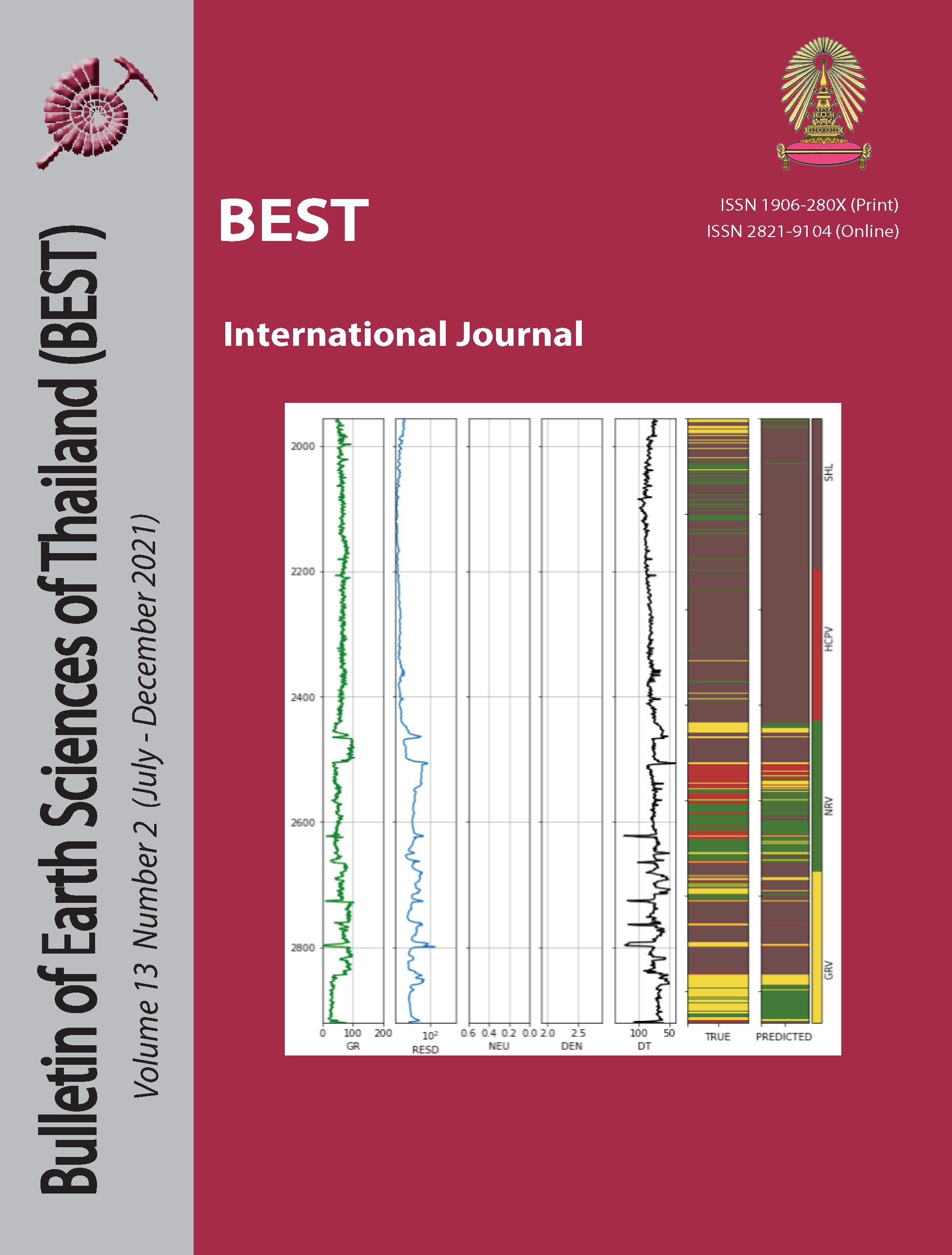Pay Zone Determination by Applying Automatic Machine Learning (AutoML) in the Mckee Field, Taranaki Basin, New Zealand
Main Article Content
Abstract
Reservoir characterization is a critical objective in order to understand the subsurface geology and develop geological models that support sustainable and economic oil and gas exploitation. By measuring and analyzing electrical responses of the penetrated successions, it is possible to infer properties about rock matrix and fluid content, among others, that are indirectly related to petrophysical properties of the rocks. Machine Learning (ML) is a data science tool that fits models that are then used to identify patterns or similarities among observations in a dataset in order to make predictions about unobserved data. The main objective of this study is to build a supervised classification model applying AutoML (Automatic Machine Learning) to identify pay zones using information derived from well logs. Twenty wells from the Mckee field, Taranaki Basin, New Zealand were selected containing a basic set of electric logs. For the response variable, reservoir pay properties were estimated. The classification model was first trained with a proportion of the observed data for the independent and response variables and then tested against the remained data set not observed by the model. Model definition and implementation were done with the AutoML function from H2O open source, and model performance was assessed by means of the confusion matrix method. The results indicate that XGBoost (Extreme Gradient Boosting) is the best model for the classification of the Mckee field and that the correct classification of the pay properties is high in all tested wells. This suggests that AutoML procedures can be a valuable tool for the exploration and assessment of the geological properties of the area, helping to reduce operating costs by optimizing the decision-making time during the well evaluation phase as well as the initial petrophysical evaluation to understand reservoir characteristics.
Article Details

This work is licensed under a Creative Commons Attribution-NonCommercial-NoDerivatives 4.0 International License.
Copyright © 2008 Department of Geology, Faculty of Science, Chulalongkorn University. Parts of an article can be photocopied or reproduced without prior written permission from the author(s), but due acknowledgments should be stated or cited accordingly.
References
Abbey, C. P., Okpogo, E. U., & Atueyi, I. O. 2018. Application of rock physics parameters for lithology and fluid prediction of ‘TN’ field of Niger Delta basin, Nigeria. Egyptian Journal of Petroleum, 27(4), 853–866. https://doi.org/10.1016/j.ejpe.2018.01.001
Bangert, P. 2021. Introduction to Machine Learning in the Oil and Gas Industry. In Machine Learning and Data Science in the Oil and Gas Industry (pp. 69–81). Elsevier. https://doi.org/10.1016/b978-0-12-820714-7.00004-2
Cuddy, S. 2021. The benefits and dangers of using artificial intelligence in petrophysics. Artificial Intelligence in Geosciences, 2, 1–10. https://doi.org/10.1016/j.aiig.2021.04.001
Dong, S. P., Shalaby, M. R., & Islam, M. A. 2018. Integrated reservoir characterization study of the McKee formation, Onshore Taranaki Basin, New Zealand. Geosciences (Switzerland), 8(4). https://doi.org/10.3390/geosciences8040105
Elhassan, A., Abu-Soud, S. M., Alghanim, F., & Salameh, W. 2021. ILA4: Overcoming missing values in machine learning datasets – An inductive learning approach. Journal of King Saud University - Computer and Information Sciences. https://doi.org/10.1016/j.jksuci.2021.02.011
Gu, Y., Zhang, D., & Bao, Z. 2021. Lithological classification via an improved extreme gradient boosting: A demonstration of the Chang 4+5 member, Ordos Basin, Northern China. Journal of Asian Earth Sciences, 215. https://doi.org/10.1016/j.jseaes.2021.104798
Imamverdiyev, Y., & Sukhostat, L. 2019. Lithological facies classification using deep convolutional neural network. Journal of Petroleum Science and Engineering, 174, 216–228. https://doi.org/10.1016/j.petrol.2018.11.023
Ippolito, M., Ferguson, J., & Jenson, F. 2021. Improving facies prediction by combining supervised and unsupervised learning methods. Journal of Petroleum Science and Engineering, 200. https://doi.org/10.1016/j.petrol.2020.108300
Japkowicz, N. 2000. Learning from Imbalanced Data Sets: A Comparison of Various Strategies *. www.aaai.org
King, P.R. & Thrasher, G.P. 1996. Cretaceous-Cenozoic geology and petroleum systems of the Taranaki Basin, New Zealand. Institute of Geological and Nuclear Sciences monograph 13. 243 p, 6 enclosures. Lower Hutt, New Zealand: Institute of Geological & Nuclear Sciences Limited
Li, Y., & Anderson-Sprecher, R. 2006. Facies identification from well logs: A comparison of discriminant analysis and naïve Bayes classifier. Journal of Petroleum Science and Engineering, 53(3–4), 149–157. https://doi.org/10.1016/j.petrol.2006.06.001
Malik, M. 2020. A Hierarchy of Limitations in Machine Learning. http://arxiv.org/abs/2002.05193
Min, X., Pengbo, Q., & Fengwei, Z. 2020. Research and application of logging lithology identification for igneous reservoirs based on deep learning. Journal of Applied Geophysics, 173. https://doi.org/10.1016/j.jappgeo.2019.103929
Ministry of Business, Innovation, and Employment, New Zealand. 2014. New Zealand Petroleum Basins. New Zealand Petroleum & Minerals. Report. ISNN 2324-3988.
Otchere, D. A., Ganat, T. O. A., Gholami, R., & Lawal, M. 2021. A novel custom ensemble learning model for an improved reservoir permeability and water saturation prediction. Journal of Natural Gas Science and Engineering, 91. https://doi.org/10.1016/j.jngse.2021.103962
Saporetti, C.M., Goliatt, L. and Pereira, E. 2021. Neural network boosted with differential evolution for lithology identification based on well logs information. Earth Science Informatics,14(1), 133-140.
Thomas, E., Sneider, R., Neasham, J, and Vinegar, H. 1995. A catalog of petrophysical and geological properties of typical reservoir rocks. Update Published as Technical Progress Report BTC, pp 12–95
Vasini, E. M., Battistelli, A., Berry, P., Bonduà, S., Bortolotti, V., Cormio, C., & Pan, L. 2018. Interpretation of production tests in geothermal wells with T2Well-EWASG. Geothermics, 73, 158–167. https://doi.org/10.1016/j.geothermics.2017.06.005
Xie, Y., Zhu, C., Zhou, W., Li, Z., Liu, X., & Tu, M. 2018. Evaluation of machine learning methods for formation lithology identification: A comparison of tuning processes and model performances. Journal of Petroleum Science and Engineering, 160, 182–193. https://doi.org/10.1016/j.petrol.2017.10.028
Yang, H., Xu, Y., Peng, G., Yu, G., Chen, M., Duan, W., Zhu, Y., Cui, Y., & Wang, X. 2017. Particle swarm optimization and its application to seismic inversion of igneous rocks. International Journal of Mining Science and Technology, 27(2), 349–357. https://doi.org/10.1016/j.ijmst.2017.01.019
Zeng, L., Ren, W., & Shan, L. 2020. Attention-based bidirectional gated recurrent unit neural networks for well logs prediction and lithology identification. Neurocomputing, 414, 153–171. https://doi.org/10.1016/j.neucom.2020.07.026
Zhong, R., Johnson, R., & Chen, Z. 2020. Generating pseudo density log from drilling and logging-while-drilling data using extreme gradient boosting (XGBoost). International Journal of Coal Geology, 220. https://doi.org/10.1016/j.coal.2020.103416


